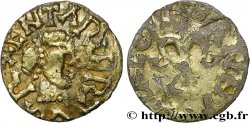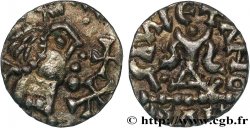bmv_472284 - MEROVINGIAN COINAGE - BANASSAC (BANNACIACO) - Lozere Triens aux deux croix
Not available.
Item sold on our e-shop (2018)
Price : 2 000.00 €
Item sold on our e-shop (2018)
Price : 2 000.00 €
Type : Triens aux deux croix
Date: c. 620-640
Mint name / Town : Banassac (48)
Metal : gold
Diameter : 12,5 mm
Orientation dies : 11 h.
Weight : 1,20 g.
Rarity : R3
Officine: OR6
Coments on the condition:
Flan un peu court, mais avec des types bien centrés. Patine un peu plus foncée autour des reliefs
Catalogue references :
Predigree :
Cet exemplaire provient de la collection Raymond D. (1948-2017), il a été acquis auprès de C.N.B. en novembre 1992 (6.000 fr).
Analysé par A. Pol, ce triens CMM 15536 est titré à 26% d’or.
Obverse
Obverse legend : ANÉPIGRAPHE.
Obverse description : Tête barbare diadémée, à droite ; diadème perlé ; deux croisettes devant le visage.
Reverse
Reverse legend : GAV[ALETAN]O // BAH.
Reverse description : Calice à deux anses, posé sur une ligne d’exergue perlée.
Commentary
Pour le Type 12-2E / 23, avec les deux croisettes devant le buste, le Moneta liste 16 exemplaires, dont quatre proviennent du trésor de Bordeaux.
Les triens de ce type sont attribués à SIGEBERT et sont relativement abondants ce qui a permis d'en réaliser une étude précise, avec des différenciations parfois subjectives !.
Les triens de ce type sont attribués à SIGEBERT et sont relativement abondants ce qui a permis d'en réaliser une étude précise, avec des différenciations parfois subjectives !.








 Report a mistake
Report a mistake Print the page
Print the page Share my selection
Share my selection Ask a question
Ask a question Consign / sell
Consign / sell
 Full data
Full data